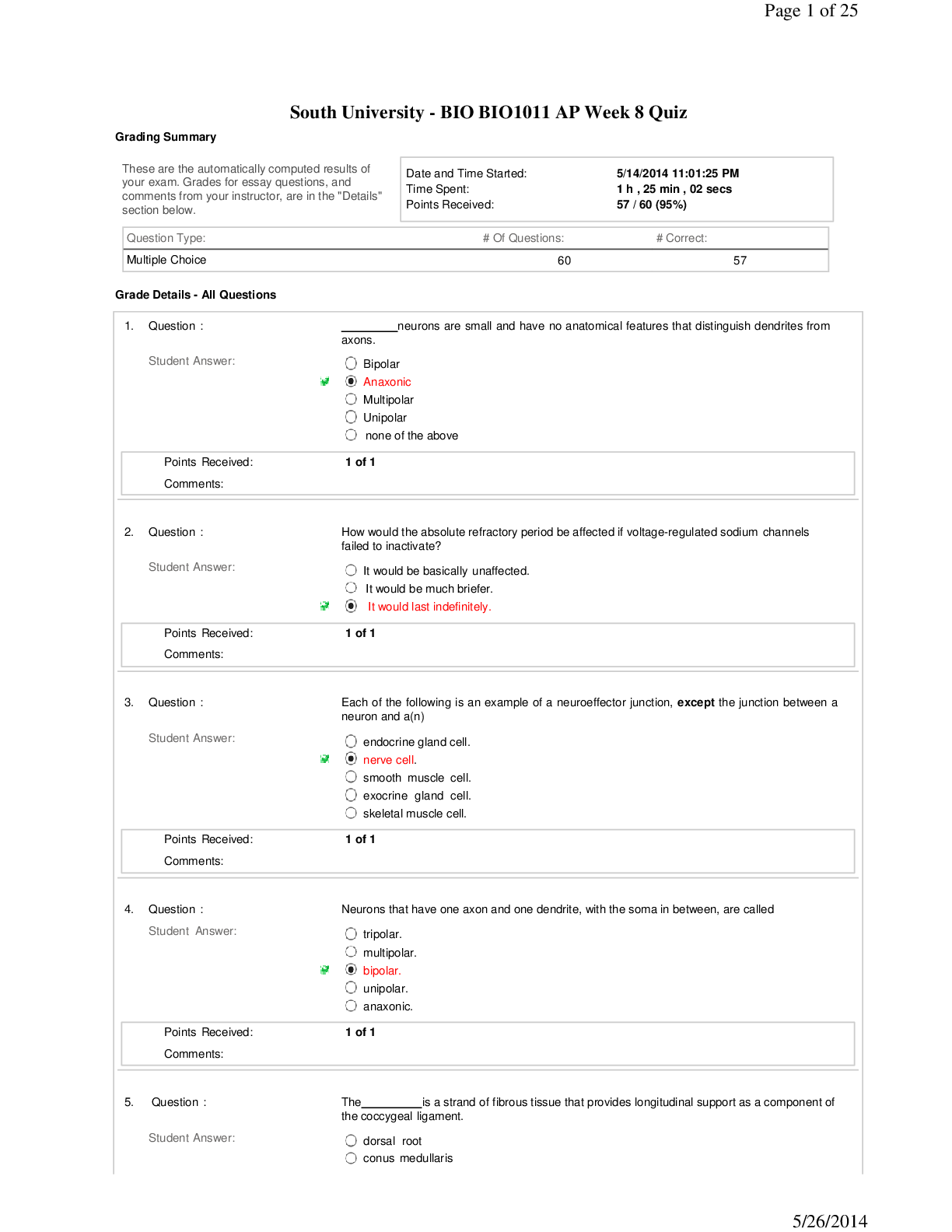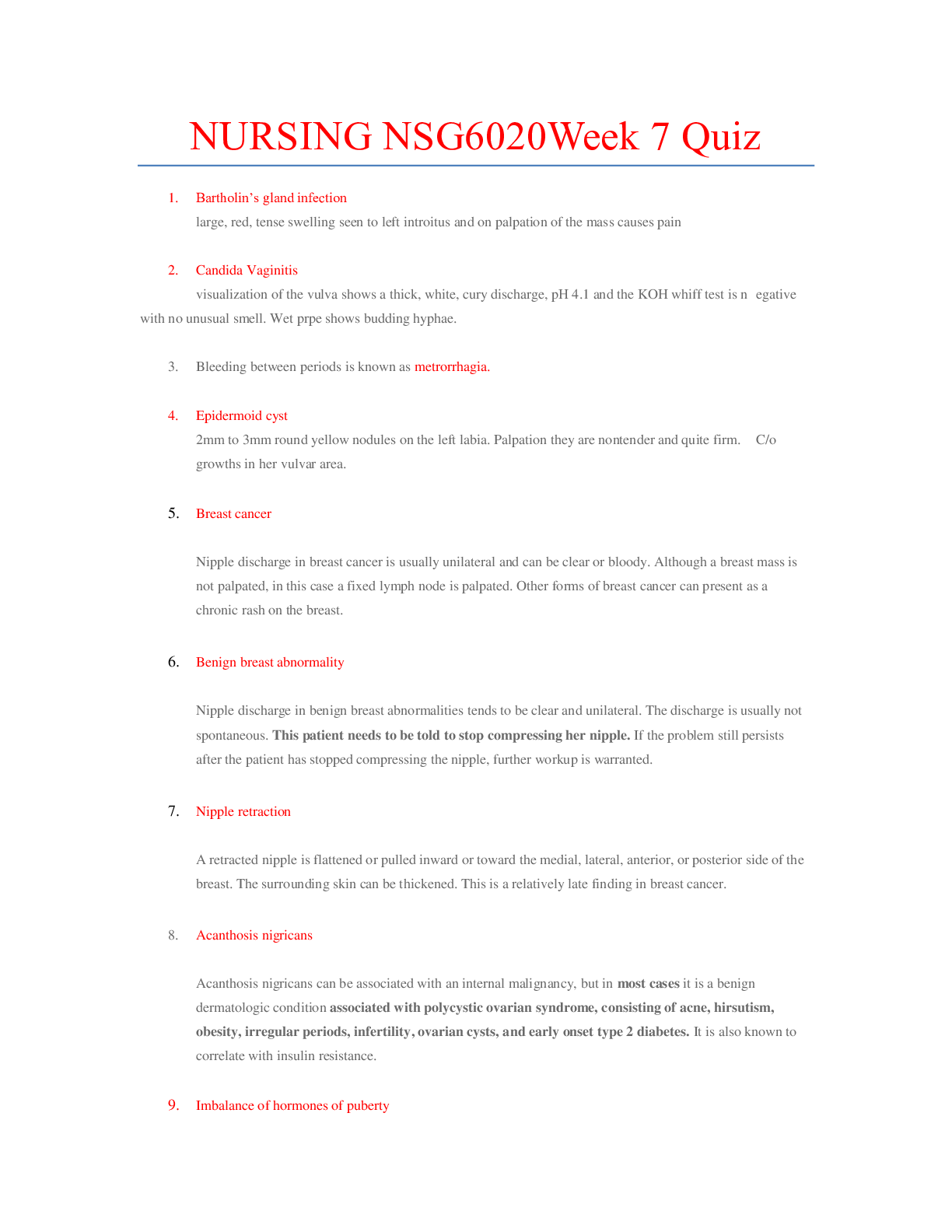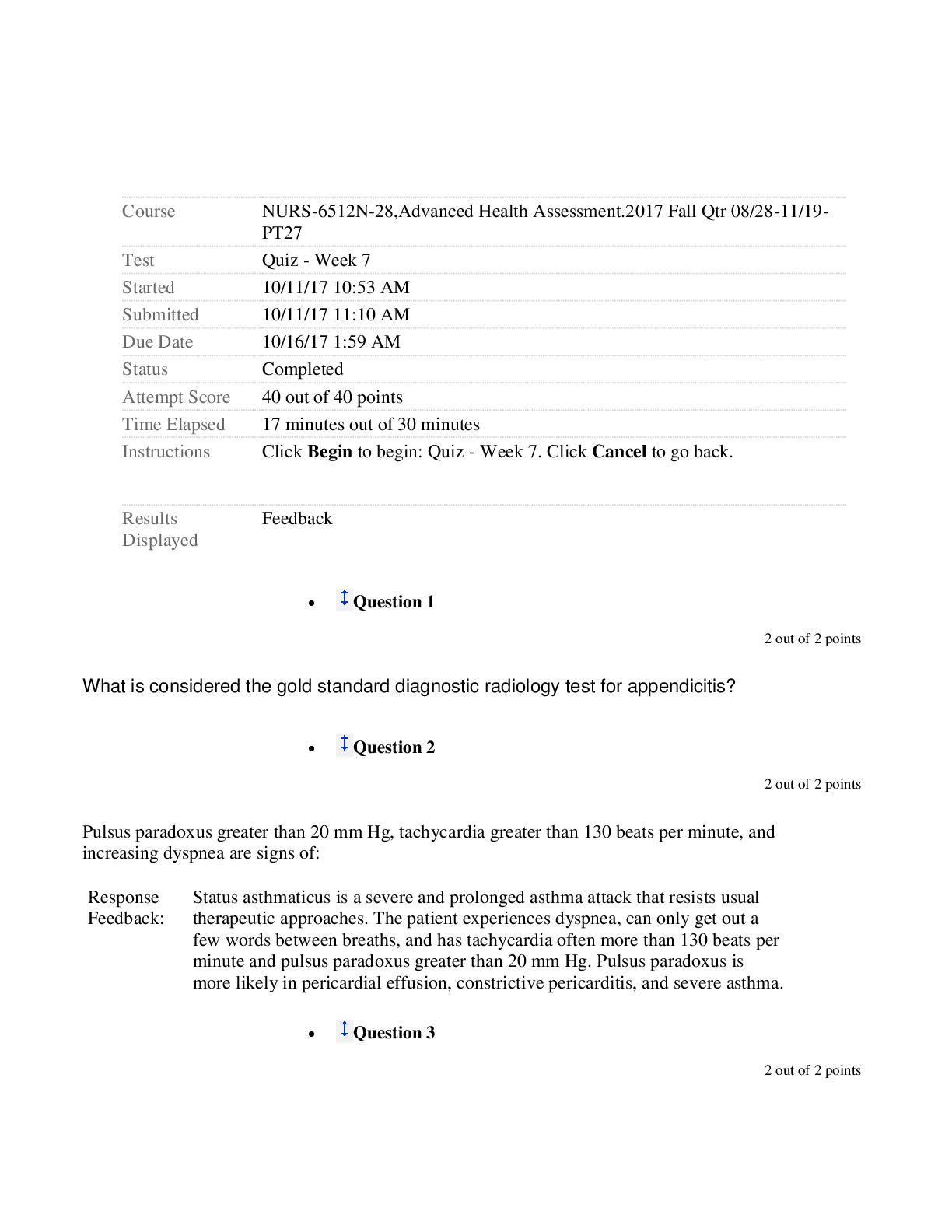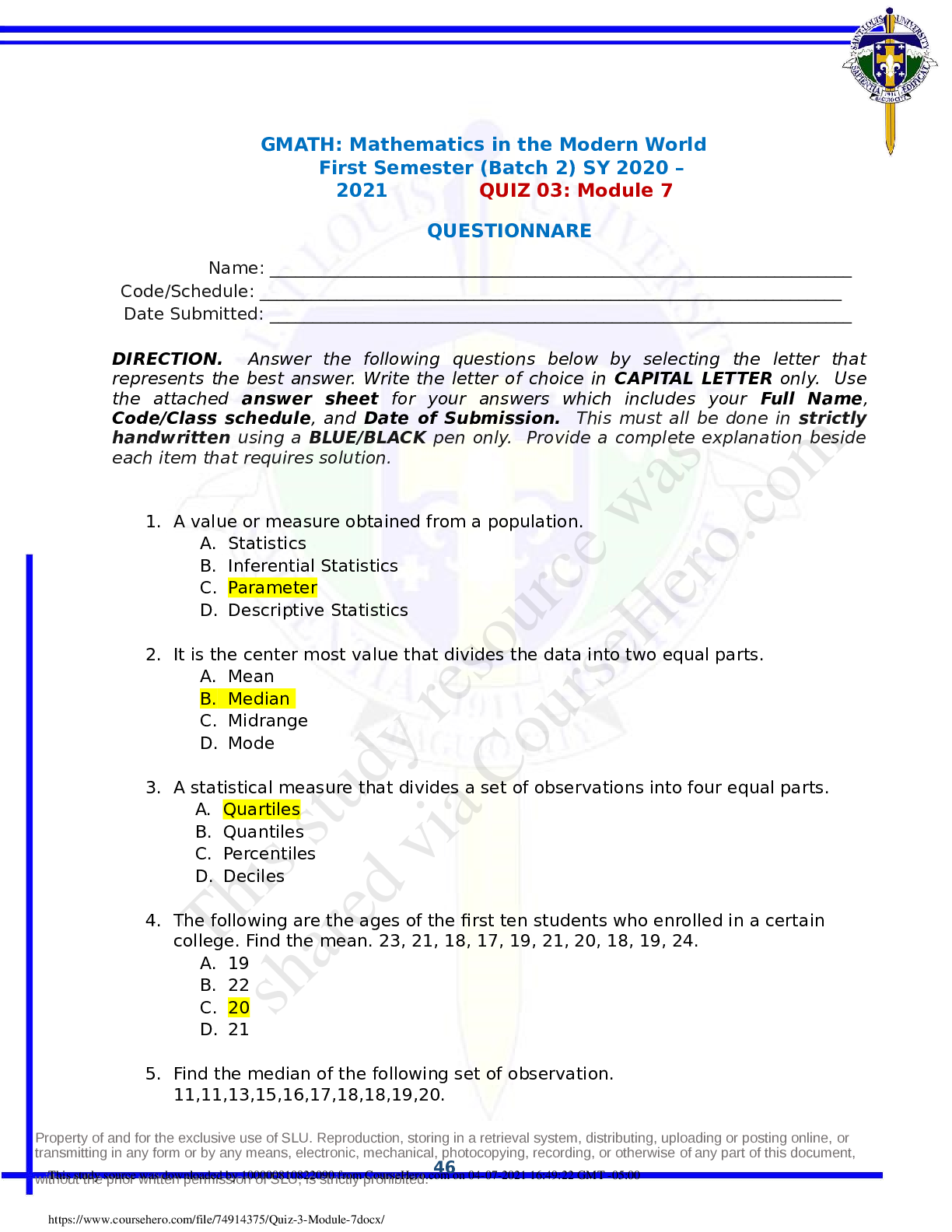Anatomy and Physiology - A&P 2 > EXAM > Straighterline AP2 202 Anatomy & Physiology 2 A&P 2 test 10 Grade 40.00 out of 40.00 (100%) (All)
Straighterline AP2 202 Anatomy & Physiology 2 A&P 2 test 10 Grade 40.00 out of 40.00 (100%)
Document Content and Description Below
Straighterline AP2 202 Anatomy & Physiology 2 A&P 2 test 10 Grade 40.00 out of 40.00 (100%) Question 1 Question text The primary regulator of plasma sodium concentration is Select one: a.... renin. b. aldosterone. c. antidiuretic hormone (ADH). d. atrial natriuretic hormone. e. insulin. Question 2 Question text Which of the following will the body begin to do in order to compensate for hyperkalemia? Select one: a. vasoconstriction of blood vessels b. increase ADH secretion c. decrease aldosterone secretion d. increase the release of atrial natriuretic hormone e. increase aldosterone secretion Question 3 Question text Once alkalosis has occurred, which of the following would you expect to happen? Select one: a. increased respiratory rate b. a plasma pH less than 7.40 c. retention of hydrogen ions by the kidney d. increased renal reabsorption of bicarbonate ions e. secretion of hydrogen ions by the kidney Question 4 Question text Which of the following is not a function of the carbonic acid/bicarbonate system? Select one: a. Regulation of the pH of the intracellular environment b. Regulating pH changes of the blood during exercise c. Regulation of blood pH during elevated fat matabolism d. Regulation of blood pH in coordination with the respiratory system e. Regulation of blood pH in coordination with the kidneys Question 5 Question text Body fluid pH will rise dramatically when Select one: a. sodium is excreted by the kidney. b. large amounts of bicarbonate are ingested. c. carbonic acid is formed. d. the respiratory rate decreases. e. carbon dioxide levels increase. Question 6 Question text Which of the following statements concerning potassium ions is false? Select one: a. An increase in the extracellular potassium ion concentration leads to depolarization. b. Potassium ions are secreted into the nephron by the distal convoluted tubule. c. When aldosterone levels are high, potassium secretion is low. d. Aldosterone secretion is stimulated by high blood levels of potassium ions. e. None of these choices is false. Question 7 Question text Which of the following fluid compartments contains the smallest volume of water? Select one: a. plasma b. interstitial compartment c. intracellular compartment d. extracellular compartment e. cytoplasm Question 8 Question text Calcitonin Select one: a. promotes the absorption of calcium from the gastrointestinal tract. b. promotes osteoclast activity in the bones. c. reduces calcium excretion by the kidneys. d. reduces extracellular calcium ion levels. e. increases blood calcium levels. Question 9 Question text Potassium levels in the body are regulated by Select one: a. ADH. b. PTH. c. calcitonin. d. aldosterone. e. insulin. Question 10 Question text Calcium balance is influenced by Select one: a. ADH and parathyroid hormone levels. b. ADH and aldosterone levels. c. parathyroid hormone and vitamin D levels. d. aldosterone and parathyroid hormone levels. e. insulin and glucagon. Question 11 Question text Which of the following events occurs last? Select one: a. release of renin by the kidney b. release of aldosterone by the adrenal cortex c. sodium reabsorption by the kidney tubules d. angiotensinogen → angiotensin I e. angiotensin I → angiotensin II Question 12 Question text If the hydrogen ion concentration in the blood increases, bicarbonate ions act as buffers by Select one: a. removing excess hydrogen ions from the plasma. b. releasing hydrogen ions into the plasma. c. dissociating into H+ and CO3-. d. combining with chloride ions. e. combining with hemoglobin. Question 13 Question text Hyperkalemia is defined as Select one: a. excess excitability of kalems. b. reduction of plasma calcium level. c. increase in plasma potassium level. d. increase in plasma sodium level. e. decrease in plasma potassium level. Question 14 Question text Decreased extracellular potassium levels cause Select one: a. cells to become more excitable. b. hyperpolarization of cell membranes. c. more action potentials to be generated. d. increased permeability of cell membranes. e. hypopolarization of cell membranes. Question 15 Question text A person working in the hot sun loses the greatest amount of water from the Select one: a. lungs. b. urine. c. mouth. d. skin. e. GI tract. Question 16 Question text In renal compensation of acidosis, Select one: a. H+ secretion decreases; bicarbonate excretion increases. b. H+ secretion decreases; bicarbonate reabsorption increases. c. H+ secretion increases; bicarbonate reabsorption increases. d. H+ secretion increases; bicarbonate excretion increases. e. H+ secretion decreases; bicarbonate excretion decreases. Question 17 Question text Name the ion that commonly serves as a cofactor for intracellular enzymes, such as the sodiumpotassium pump. Select one: a. Magnesium b. Calcium c. Hydrogen d. Carbonate e. Phosphate Question 18 Question text Which of the following is most likely to happen to a group of students who relax by drinking a pitcher of their favorite beverage? Select one: a. an increase in urine volume b. an increase in urine osmolality c. an increase in ADH production d. increased aldosterone secretion e. a decrease in urine volume Question 19 Question text Case study: You have just admitted Mary Roberts, a 70-year-old woman, to the hospital for GI bleeding. Her blood pressure is 130/80, pulse 80/min and irregular, respirations 18/min, and temperature 99.2. Mrs. Roberts denies pain at this time although she appears anxious and very pale. Her medical history includes lung cancer that was diagnosed two weeks ago, peptic ulcer disease with reflux esophagitis, and "fluid retention". Admission lab work shows a plasma Na+ of 152 mEq/L and K+ of 2.8 mEq/L. The increase in extracellular osmolality would cause Select one: a. water to move out of the cells. b. water to move into the cells. c. no change in the net movement of water into or out of the cells. Question 20 Question text Case study: You have just admitted Mary Roberts, a 70-year-old woman, to the hospital for GI bleeding. Her blood pressure is 130/80, pulse 80/min and irregular, respirations 18/min, and temperature 99.2. Mrs. Roberts denies pain at this time although she appears anxious and very pale. Her medical history includes lung cancer that was diagnosed two weeks ago, peptic ulcer disease with reflux esophagitis, and "fluid retention". Admission lab work shows a plasma Na+ of 152 mEq/L and K+ of 2.8 mEq/L. Which of the following regulatory mechanisms would be stimulated as a result of the increased osmolality that results from a Na+ level of 152 mEq/L? Select one: a. increased urine output b. an increased release of ADH c. an increase in renin production d. an increase in the secretion of aldosterone e. a decreased release of ADH [Show More]
Last updated: 2 years ago
Preview 1 out of 9 pages

Buy this document to get the full access instantly
Instant Download Access after purchase
Buy NowInstant download
We Accept:

Reviews( 0 )
$7.00
Can't find what you want? Try our AI powered Search
Document information
Connected school, study & course
About the document
Uploaded On
Aug 04, 2022
Number of pages
9
Written in
Additional information
This document has been written for:
Uploaded
Aug 04, 2022
Downloads
0
Views
88











.png)














